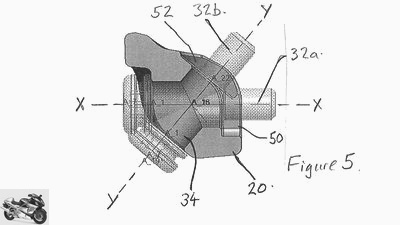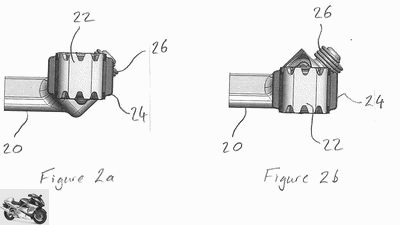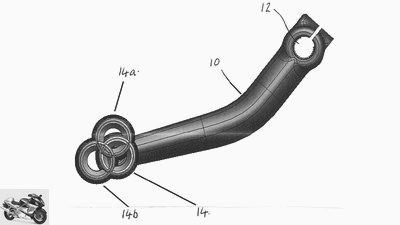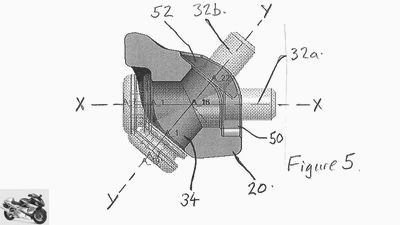Table of contents
- Triumph adjusts footpegs Triumph with tool-free pedal adjustment
- Pivoting foot levers should help
- Use on the footrests themselves is conceivable
- Conclusion

Triumph Motorcycles




4th pictures

Triumph Motorcycles
1/4
The footrest # 22 is still hinged on the brake lever # 20. For the tool-free adjustment system, Triumph has developed a swiveling bearing pin # 32, which can be rotated in height using the spring groove # 26.

Triumph Motorcycles
2/4
If the lever is centrally located on the bolt, a height adjustment of at least 50 percent of the overall height of the lever is possible. Eccentrically mounted accordingly more or less.

Triumph Motorcycles
3/4
The pivoting bearing pin of the foot lever seems to be independent of the screw bolt of the lever, which makes replacement easier, as other foot levers could probably also be mounted in this way.

Triumph Motorcycles
4/4
Using the example of foot brake lever # 10, the start and end positions # 14 and 14a can be clearly seen, the turning path seems to be in the direction of travel.
Triumph patent: foot levers that can be adjusted without tools
Triumph adjusts footpegs
Triumph with tool-free pedal adjustment
According to a patent application, Triumph developed a system for the tool-free adjustment of foot levers to adjust the ergonomics of the seat. The expansion into a combination system consisting of the adjustment of the actual footrest and the foot lever is conceivable.
Jens Kratschmar
01/08/2021
The patents of triumph address above all the point that the previous systems for adjusting the foot levers can only be done with a tool or even only in the workshop. But especially when driving off-road – and this is what the system seems to be primarily developed for – simpler adjustment of the ergonomics to the application or the boots being worn make sense.
Pivoting foot levers should help
Triumph’s patent is concerned with adjusting the foot levers, in this case the brake lever, by means of a swiveling catch, completely without tools. The pivotable bearing pin of the brake lever detent can be adjusted in height in two positions, which is possible by means of a spring on the rear in which the pin is rotatably mounted. In the registration, Triumph does not exclude the use of the system for the side of the footshift lever. Should the system come up like this, a noticeable gain in comfort on the Triumph is conceivable. And in fact, this patent went into series production on the new Triumph Tiger 900 Rally.
Use on the footrests themselves is conceivable
The adjustment of the foot levers, especially in terms of height, is implemented in most cases by adjusting the length of the threaded rod or changing the lever height directly on the brake pump. Tools are required in both cases. Both are neither nice nor desirable in off-road operation, if only because of the dirt and dust, which then has the way to the mechanics. If you continue to spin the approach with the pivoting bearing bolt, you also open up a number of options for the footpegs themselves. Due to the larger structure of the notch support compared to the foot lever, even more than two height positions would be conceivable here. Pushed to the extreme, there are six possible positions in which the notch can be adjusted. In combination with the rotatable foot lever, a Triumph Tiger can be adapted very well to the feet.

Triumph Motorcycles
The pivoting bearing pin of the foot lever seems to be independent of the screw bolt of the lever, which makes replacement easier, as other foot levers could probably also be mounted in this way.
Conclusion
It might not look like much, but the approach and mechanical simplicity of the Triumph patent sound like a lot of brainpower. And with a view to the booming accessory market for adjustable footrests and levers, this technology should – when it comes – meet with many friends – except for the accessory manufacturers.
Related articles
-
Aprilia patent: comeback of the anti-dive system
Piaggio Group 7th pictures Piaggio Group 1/7 The Piaggio subsidiary Aprilia has patented a mechanical anti-dive system. Piaggio Group 2/7 A corresponding…
-
Brake and clutch levers care and replacement
Schermer counselor workshop Brake and clutch levers care and replacement Workshop: hand lever maintenance and new acquisition Brake and clutch levers…
-
counselor workshop Adjust shift and brake levers Adjust shift and brake levers Adjust shift and brake levers The levers have to be positioned correctly…
-
Triumph Speed Triple 1200 RS: Almost everything new
News 2022 New motorcycle items for 2022 Triumph Motorcycles 44 pictures Triumph Motorcycles 1/44 The new Speedy 1200 RS has new headlights that are very…
-
PS-TuneUp Triumph Daytona 675 race track tuning
Feulner 17th pictures Andreas Feulner 1/17 PS-TuneUp has set itself the task of forging a good racing athlete into a hot race track sweeper with the…
-
Bosch patent for electric motor with ABS: brake charges battery
Bosch counselor technology & future Bosch patent for electric motor with ABS: brake charges battery Bosch patent for electric motor with ABS Brake…
-
On the move with the BMW R 90 S, Moto Guzzi Le Mans and Triumph Bonneville
Rein van der Zee 13th pictures Rein van der Zee 1/13 Top and bottom: At Saint-Martin, a narrow hanging structure spans the Ardèche. This is where the…
-
Used advice Triumph Trident 750-900
counselor Used purchase Used advice Triumph Trident 750/900 Used advice Triumph Trident 750/900 The English patient In 1991 the classic company name…
-
Honda patent new variable valve timing
Honda 12th pictures Honda 1/12 Honda has patented a new variable valve control. Honda 2/12 The new variable valve control in the engine of the upcoming…
-
Honda patent: head-up display for motorcycles
Honda 16 pictures Honda 1/16 Honda is considering new control and information systems on the motorcycle. Honda 2/16 Now the Japanese have patented a…